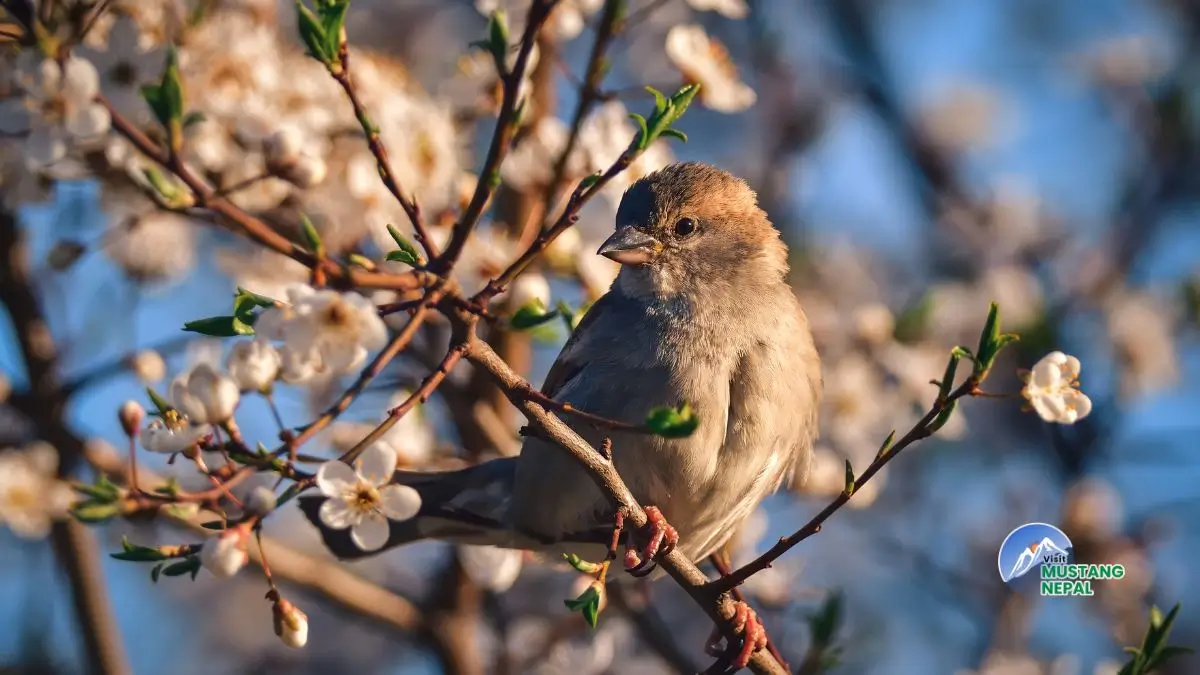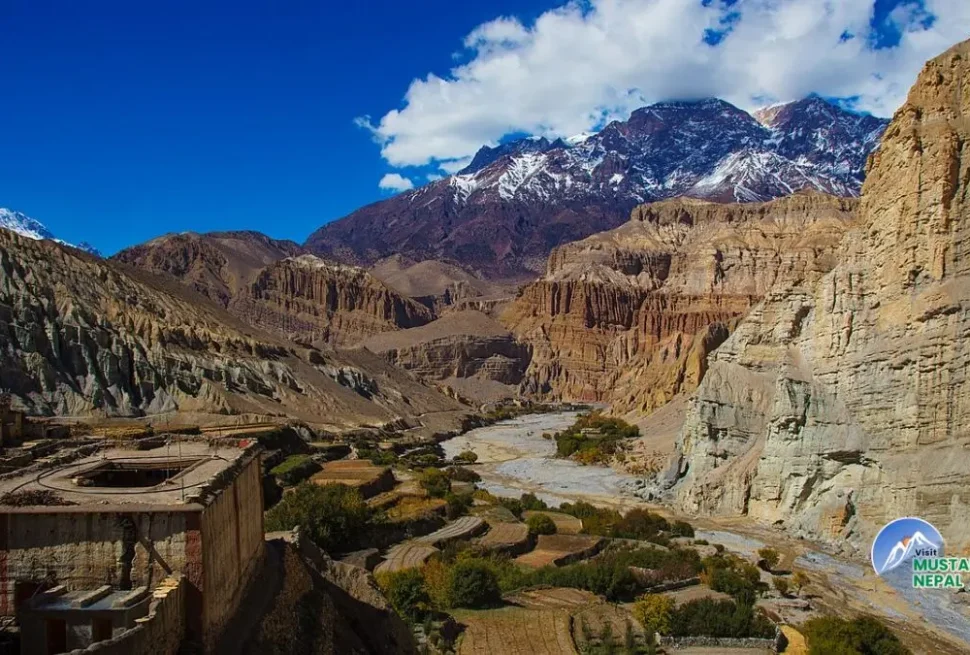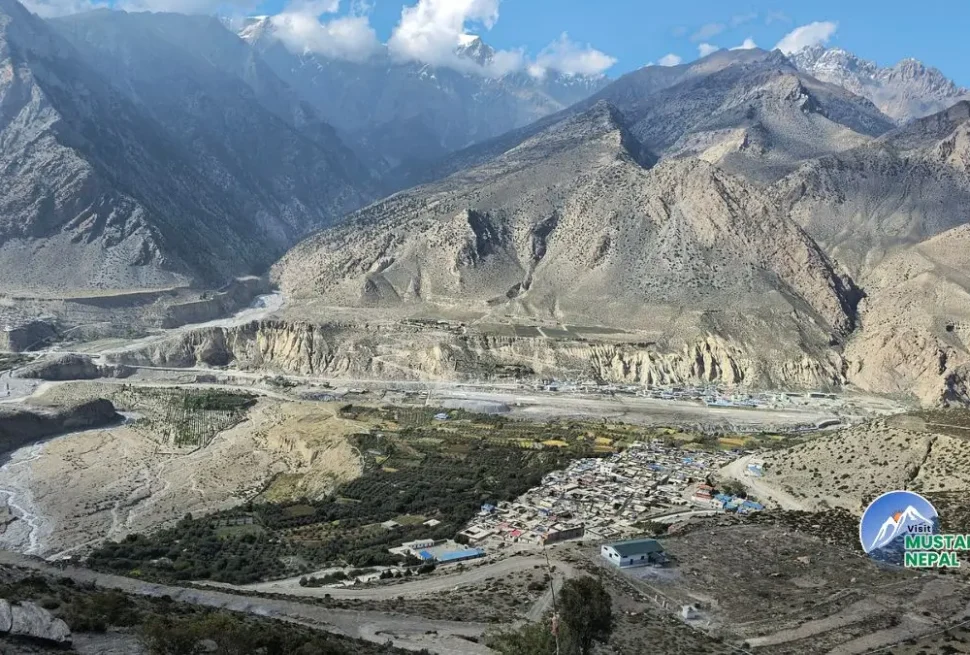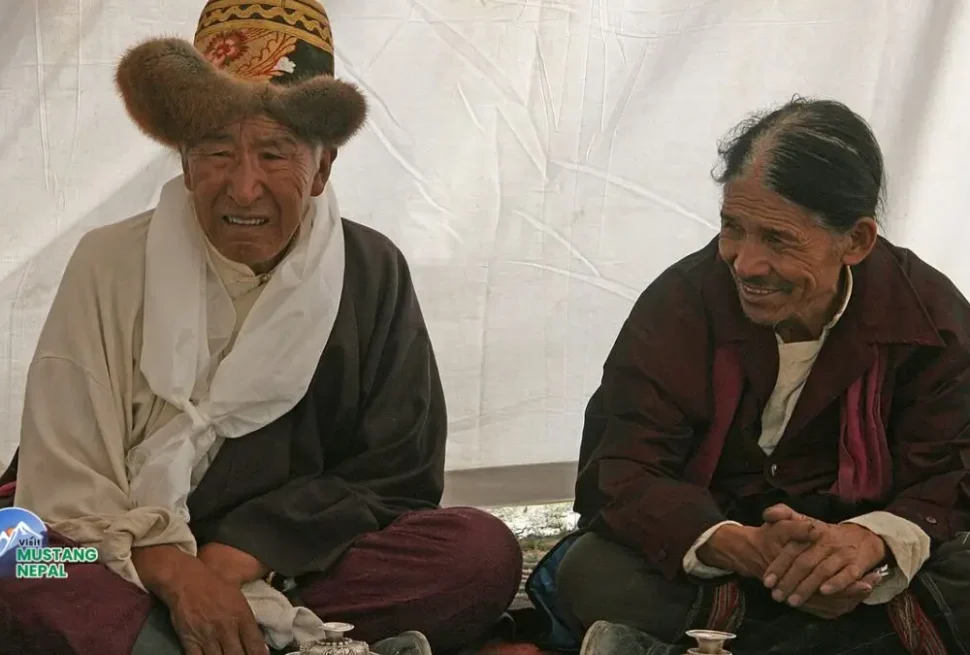For travelers like you, Mustang offers not only breathtaking landscapes but also a chance to witness one of the most unique ecosystems in the Himalayas. Mustang is located in the rain shadow of the mighty Annapurna and Dhaulagiri massifs. This trans-Himalayan region, often called the “Last Forbidden Kingdom.” The flora and fauna of Mustang make it one of Nepal’s most fascinating high-altitude ecosystems.
“According to Wikipedia, Mustang lies in Nepal’s rain shadow region, creating its distinctive desert-like environment.”
The geography of Mustang creates a unique ecological niche where Tibetan Plateau species meet Himalayan wildlife, resulting in an ecosystem unlike anywhere else on Earth. The rain-shadow effect, caused by massive mountain barriers blocking moisture-laden clouds from the south, creates an arid landscape that receives less than 250mm of annual precipitation. This harsh environment has given rise to specially adapted plants and animals that make Mustang a living laboratory of evolution.
Ready to discover Mustang’s hidden wildlife? Join our guided eco-treks.
Flora of Mustang – Life in the High Himalayas
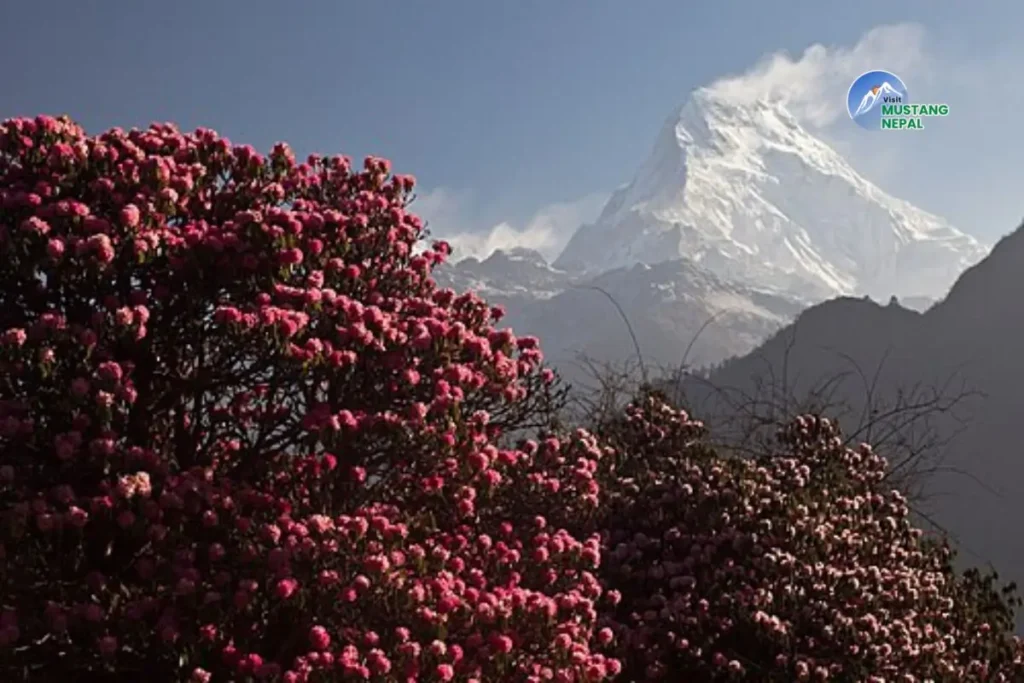
The flora of Mustang, Nepal, ranges from lush forests in the south to alpine herbs in the north. Mustang’s plant life is a tale of adaptation and survival in one of the harshest places on Earth. This area is home to an incredible variety of plant species, many of which are unique to this region. This diversity ranges from the dense forests of Lower Mustang to the sparse yet hardy vegetation of the upper reaches. In April, botany enthusiasts can hike the Upper Mustang Trek to witness these blossoms for themselves.
Alpine Shrubs and Wildflowers
- Junipers – natural bonsai of the Himalayas
- Rhododendrons – splashes of red, pink, and white
- Edelweiss & Blue poppies – iconic alpine flowers
- Ephedra (Joint fir) – moisture-saving shrub
Juniperus and Rhododendron species, as documented in the Flora of Nepal, dominate the alpine vegetation zones of Mustang. The hardy vegetation of Mustang’s alpine zones represents nature’s triumph over adversity.
The backbone of the shrub communities in the area is juniper (Juniperus species), whose twisted, wind-sculpted forms produce natural bonsai gardens all over the terrain. These centuries-old junipers help sustain the delicate soil while offering wildlife vital cover and nesting locations.
Rhododendron species paint the hillsides with brilliant colors during blooming season, with varieties ranging from the diminutive alpine forms to larger shrubs in protected valleys. Caragana species, hardy leguminous shrubs, contribute nitrogen to the poor soils while providing browse for wild animals.
You can stop for photography in meadows covered with edelweiss and blue poppies. Ephedra, known locally as “joint fir,” grows in dense cushions across rocky slopes, its jointed stems adapted to conserve precious moisture.
The wildflower displays of Mustang are legendary among botanists and trekkers alike. Edelweiss (Leontopodium species), the iconic symbol of high mountain beauty, carpets meadows with its woolly white stars. Wild poppies burst from rocky crevices in brilliant shades of blue and yellow, while alpine herbs create intricate tapestries of color and texture across the high pastures.
Medicinal Plants in Mustang
- Jimbu – onion-like herb for food & medicine
- Yarshagumba – “Himalayan gold,” a caterpillar fungus worth thousands of dollars per kg
- 200+ herbs used by Amchi healers
Mustang has many special plants over 200 kinds that are really important for traditional Tibetan medicine. Among the most valued flora of Mustang, Nepal are medicinal herbs like Jimbu and Yarshagumba. There are healers called Amchi who know how to use these plants to help people. Visitors can meet Amchi healers and learn about these plants during guided cultural tours in Mustang.
One important plant is Jimbu, which looks like an onion and grows on steep hills. It’s used in cooking and as medicine. Another is Yarshagumba, a rare fungus that grows on caterpillars and is very valuable, earning a lot of money for local people. Amchi healers have learned how to use these plants over hundreds of years and teach others in their community, helping to keep their culture and the environment healthy.
Ready to uncover the flora of Mustang? Plan your Upper Mustang Trek today and experience its untouched beauty, culture, and adventure.
Forests of Lower Mustang
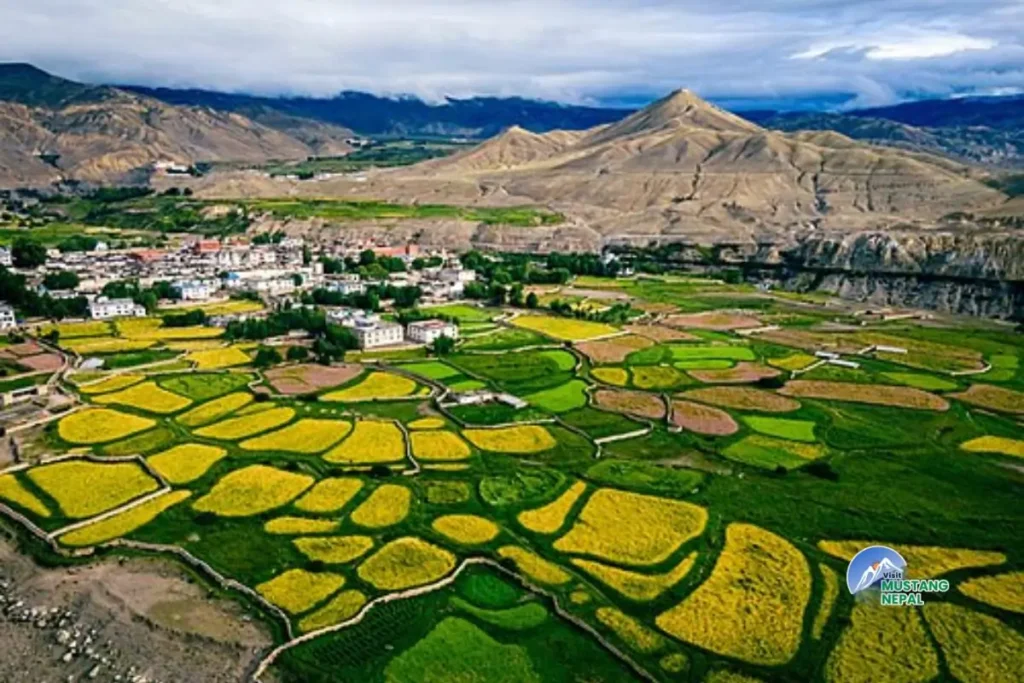
Lower Mustang forests are popular for short treks and homestay tourism. The contrast between Lower and Upper Mustang’s vegetation is striking and represents one of the world’s most dramatic ecological gradients over a short distance.
Lower Mustang, receiving more precipitation and enjoying milder temperatures, supports diverse forest communities that transition dramatically as elevation and aridity increase.
The middle altitudes are dominated by betula (birch) forests, which form cathedral-like groves along stream valleys thanks to their characteristic white bark and delicate foliage. While Populus (poplar) species line watercourses and produce oasis-like groves in otherwise parched areas, Pinus (pine) species build vast forests on south-facing slopes.
| Vegetation Zone | Lower Mustang | Upper Mustang |
| Dominant Trees | Betula, Pinus, Populus | Scattered Juniperus, Salix |
| Shrub Layer | Dense Rhododendron, Rosa | Sparse Caragana, Artemisia |
| Ground Cover | Rich herb layer, grasses | Cushion plants, sparse grasses |
| Annual Precipitation | 400-800mm | 150-250mm |
| Growing Season | 6-8 months | 3-4 months |
| Best Trekking Season to See | Spring (March-May) & Autumn (September-November) | Spring (March-May), Summer (June-August), & Autumn (September-November) |
Notes:
- Lower Mustang is best visited in spring and autumn for comfortable weather and clear views.
- Upper Mustang can be trekked year-round except winter (December-February) due to cold and wind; summer is drier because of the rain shadow effect.
- Spring and autumn especially offer mild temperatures, good visibility, and cultural events like the Tiji festival.
Fauna of Mustang – Wildlife of the High Plateau
The fauna of Mustang, Nepal includes snow leopards, blue sheep, and many migratory birds. They adapt to survive in harsh, high-altitude conditions. The wildlife of Mustang represents one of Earth’s most specialized assemblages of high-altitude species. These animals have evolved remarkable adaptations to survive in an environment characterized by extreme temperatures, low oxygen levels, and limited food resources. Wildlife enthusiasts can join snow leopard tracking expeditions in winter.
- Snow Leopard – The “ghost of the Himalayas,” with tails as long as their bodies for balance
- Himalayan Wolf – Larger, stronger, and adapted for pack hunting at 4,000m+
- Musk Deer – Shy forest dwellers with prized musk glands
- Blue Sheep (Bharal) – Agile cliff climbers, main prey of snow leopards
Snow leopards have tails as long as their bodies, which they use for balance and warmth in the cold mountain environment. Blue sheep, or Bharal, are exceptional climbers, able to navigate near-vertical cliffs with ease, making them the primary prey for snow leopards.
Iconic Mammals
One of the most secretive large cats in the world and Mustang’s most renowned predator is the snow leopard (Panthera uncia). These amazing cats patrol areas up to 100 square kilometers in size and are well-suited for hunting at high altitudes. Their extraordinarily long tails help them balance on perilous cliff sides, and their wide paws serve as natural snowshoes. Mustang may be home to one of Nepal’s most stable snow leopard populations, according to recent camera trap research.
The Himalayan wolf, or Canis lupus chanco, is another apex predator that has adapted to live very well in this hostile habitat. Unlike their lowland counterparts, these wolves are larger and more resilient, and they have evolved advanced pack hunting techniques to kill prey that is far larger than themselves. Their thick, light fur protects them from temperatures that can fall below -30°C and helps them blend in with the rocky terrain.
Because of their unique fang-like teeth and valuable musk glands, musk deer (Moschus species) are both intriguing and, regrettably, hunted animals that live around the borders of forests and alpine scrublands. As seed dispersers and browsers, these solitary, territorial creatures contribute significantly to the biological structure of plant communities throughout their range. Animals in the Mustang region, such as blue sheep and musk deer, are critical to the predator-prey balance.
Blue sheep or Bharal (Pseudois nayaur) serve as the primary prey species for large predators and one of the most successful large mammals in the region. Their incredible climbing abilities allow them to access food resources on near-vertical cliff faces, while their blue-gray coloration provides excellent camouflage against rocky backgrounds.
Birds of Mustang
The birds of Mustang, Nepal, include vultures, eagles, pheasants, and migratory cranes. The birds adapted to the high mountains as well as many birds passing through during migrations. The wildlife of Upper Mustang also includes rare migratory birds that rest in high valleys during seasonal movements.
There’s an impressive array of migrants that use the region’s valleys as crucial stopover points along the Central Asian flyway. Birdwatching is one of the most rewarding ways to experience the fauna of Mustang, Nepal, especially during spring migrations.
Top 5 Birds to Spot in Mustang:
- Griffon Vulture (Gyps himalayensis): Large scavenger birds that clean up animal remains, with wingspans up to 3 meters.
- Bearded Vulture (Lammergeier, Gypaetus barbatus): Known for their impressive size and role in “sky burial” cultural traditions.
- Golden Eagle (Aquila chrysaetos): Powerful predators with excellent eyesight, hunting over ridges and valleys.
- Himalayan Monal (Lophophorus impejanus): Nepal’s colorful national bird found in alpine meadows. creates rainbow displays of iridescent plumage across the alpine meadows.
- Demoiselle Crane (Anthropoides virgo): Seen during spring and autumn migrations, these elegant cranes use Mustang’s valleys as resting points.
- Cheer pheasant (Catreus wallichii) and blood pheasant (Ithaginis cruentus) add their distinctive calls to the mountain soundscape while serving as important seed dispersers for alpine plants.
Each spring and autumn, thousands of Demoiselle Cranes migrate through Mustang’s valleys, traveling thousands of kilometers between their breeding grounds in Central Asia and wintering sites in the Indian subcontinent. These migrations are among the most spectacular natural events in the region, drawing birdwatchers and nature lovers alike.
During spring and autumn migrations, Mustang’s valleys become highways for thousands of birds moving between breeding and wintering grounds. Species ranging from tiny warblers to massive demoiselle cranes (Anthropoides virgo) use the region’s passes and valleys as critical stopover points.
Small Mammals and Other Creatures
The smaller fauna of Mustang often proves more abundant and ecologically important than its larger cousins. Himalayan marmots (Marmota himalayana) create extensive burrow systems that help aerate soils while serving as prey for numerous predators. Their complex social behaviors and alarm call systems make them the “sentries of the high plateau.”
Pikas (Ochotona species), small relatives of rabbits, have become poster species for climate change adaptation in high mountains. These industrious animals spend short summers gathering vegetation into “haypiles” that sustain them through long winters, their activities creating distinctive landscape patterns across the alpine zone.
The endemic butterfly fauna of Mustang includes species found nowhere else on Earth. Three species are unique to the region, while several others represent range extensions that highlight the area’s role as a biogeographic crossroads between the Tibetan Plateau and the Himalayas.
Marmots often sunbathe near trekking trails, making them easy to spot.
Mustang’s Unique Ecosystem
It is necessary to recognize the stark contrasts between Upper and Lower Mustang, two areas that are less than 100 kilometers apart but ecologically represent completely different worlds, in order to comprehend Mustang’s biodiversity. Within a few days of walking, trekkers can witness this natural change as they make their way from Lower Mustang to Upper Mustang.This sharp contrast between Upper and Lower Mustang highlights the richness of Mustang biodiversity.
Because it receives a much more precipitation, Lower Mustang, which stretches from Kagbeni south to Tatopani, is home to forest habitats that are more typical of the larger Himalayan range. The unique high-altitude desert fauna of the upper region meets temperate Himalayan species in this transitional zone.
Upper Mustang, the restricted area north of Kagbeni, represents one of the world’s highest and most arid inhabited regions. Here, the rain-shadow effect creates a landscape more similar to the Tibetan Plateau than the green hills typically associated with Nepal. The fragile soils, extreme temperature variations, and limited growing season create conditions that support only the most specialized species.
It is impossible to overestimate the importance of the Annapurna Conservation Area (ACA) in preserving this biodiversity. The ACA, which was created in 1992, is the biggest protected area in Nepal and a trailblazing example of community-based conservation. Safeguarding the Mustang ecosystem ensures the survival of both its rare wildlife and its cultural traditions. By actively participating in habitat preservation, animal monitoring, and sustainable tourism development, local communities establish a model that strikes a balance between conservation and the needs of subsistence.
Explore Mustang’s rare plants and animals with our expert-guided eco-treks. Check Our Mustang Treks Here.
Conservation and Cultural Significance
Community-led programs play a crucial role in protecting Mustang biodiversity.
Endangered species protection (Snow Leopard, Musk Deer)
Mustang’s wildlife faces serious challenges such as habitat loss, changing climates, and conflicts with people. Iconic species like snow leopards and musk deer struggle to survive, and the Tibetan wild ass has disappeared from many areas. Some of the most threatened endangered species in Mustang include the snow leopard and musk deer. Community-led efforts remain the backbone of Mustang biodiversity protection.
Nepal is home to about 397 snow leopards, which is roughly 10% of the world’s total population. A large number of these live in protected areas such as the Annapurna Conservation Area (ACA), where ongoing conservation includes the use of camera traps and community monitoring programs. These efforts help prove that the snow leopard population is stable, and some prey species like blue sheep are recovering where hunting has been stopped.
Tourists visiting Mustang contribute to conservation through entry fees and community-led tourism programs. The government limits visitor numbers and requires guided tours to minimize human impact on wildlife and generate funds for conservation, helping protect the Mustang as an endangered species for the future.
Traditional Medicine and Ethno-botanical Practices
One of the oldest healing traditions in the world is Sowa Rigpa, the traditional Tibetan medical method used in Mustang. In-depth knowledge of regional medicinal plants, including when and how to harvest and prepare them for use as medicine, is used by Amchi healers. Many illnesses can be treated with natural treatments thanks to this knowledge, which is taught to students through apprenticeships and stories.
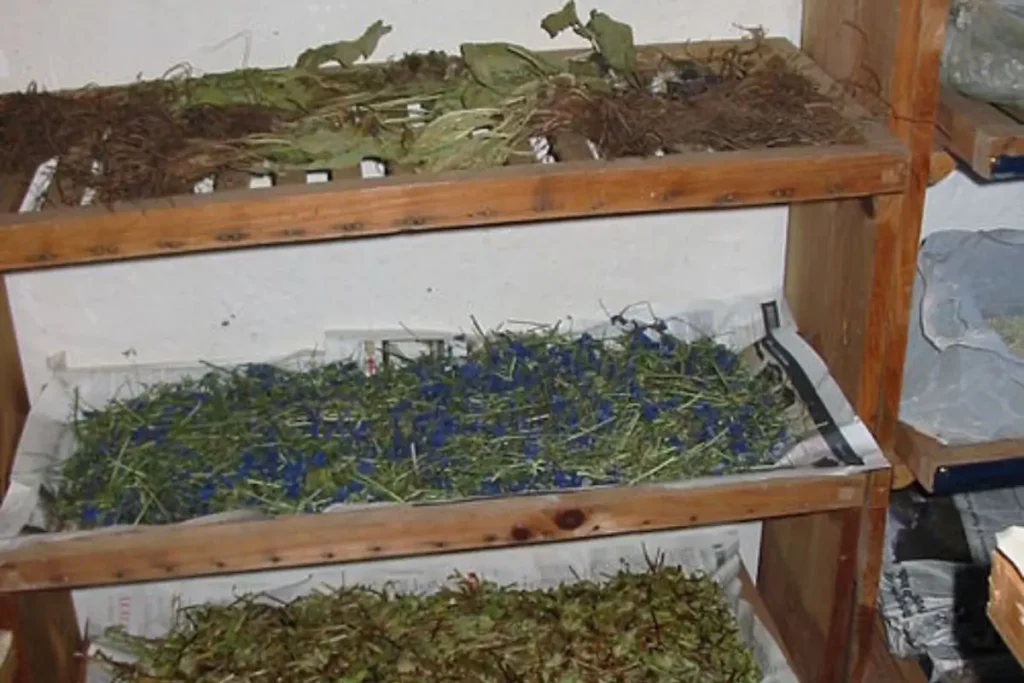
However, this wisdom is in danger due to modernity, environmental changes, and the migration of young people. Community activities preserve the traditional healing culture and the local plants by training young Amchis and documenting their practices. Amchi demonstrations in Lo Manthang are open to visitors.
Best Time to Experience Mustang’s Flora and Fauna
The best time to enjoy Mustang’s plants and wildlife is in spring (March to May) and autumn (September to November). In spring, the valleys brighten with colorful flowers, and you can see birds and animals moving around more freely. Autumn brings clear skies and golden hills, making it easier to spot local wildlife while walking through the peaceful trails. Both seasons give you the perfect setting to experience Mustang’s natural beauty.
- Spring (Mar–May): Wildflowers, bird migrations, cultural festivals
- Autumn (Sep–Nov): Clear skies, best wildlife visibility, photography treks
- Winter (Dec–Feb): Snow leopard tracking, harsh but rewarding
- Summer (Jun–Aug): Rain shadow → still trek-friendly in Upper Mustang
Spring (wildflowers, birds)
Spring → Wildflower & birdwatching treks
The best time of year to enjoy Mustang’s botanical richness is in the spring. An explosion of wildflowers turns the terrain into incredibly beautiful and diverse natural gardens when the snow melts from the high passes. Rhododendrons cover entire slopes in pink, crimson, and white, and primulas, gentians, and saxifrages blanket alpine meadows.
Bird activity reaches its peak during spring migration, with species moving north to breeding grounds, creating daily spectacles of diversity. This season also offers the best opportunities for wildlife photography, as animals emerge from winter shelters and engage in courtship behaviors.
Join our Spring Mustang Wildflower Trek to see this in bloom.
Autumn (visibility, trekking)
Autumn → Photography treks
The greatest time of year to see animals is probably in the fall, when steady weather patterns and bright sky allow for unrestricted vision. This is the best time to see larger species like blue sheep and possibly even snow leopards because many creatures are at their busiest as they get ready for winter.
Mustang’s autumnal light is renowned among photographers because of the dry air, which produces pristine conditions that make far-off mountains seem approachable. When it comes to wildlife viewing, this clarity is also evident because animals can frequently be seen far away in the open terrain. Autumn Mustang Trek is best for photographers.
Winter (snow leopard tracking)
Winter → Snow leopard tours
For those who are extremely daring, Mustang’s winter offers special opportunities, especially for tracking snow leopards. Snow leopards descend from their highest regions, making for the best encounters with these elusive cats throughout the year, while prey species congregate in lower places with available food.
The harsh winter conditions also provide insights into the remarkable adaptations of Mustang’s resident species, from the thick winter coats of blue sheep to the cached food supplies of pikas.
By trekking in Mustang, you don’t just witness wildlife, you support snow leopard conservation and help Amchi healers preserve 1,000-year-old traditions.
Final Thoughts
Did you know that Mustang’s rare caterpillar fungus, Yarshagumba, is so valuable it’s often called ‘Himalayan gold’? Or that thousands of migratory cranes use Mustang’s valleys as vital stopover points during their epic journeys across Asia? These fascinating facts are just a glimpse into the extraordinary biodiversity of Mustang.
Mustang is a unique place that is home to both native medicinal herbs and spectacular animals like the elusive snow leopard. Thus, it is one of Nepal’s most biodiverse regions. It is immensely inspiring to see how local communities have balanced conservation efforts with their means of subsistence. Because of community-led efforts, Mustang inhabitants are now dedicated stewards of this delicate ecosystem. The flora and fauna of Mustang are not just biological wonders but also cultural treasures worth protecting.
However, with increasing development pressures and the impacts of climate change, protecting Mustang’s precious plants and wildlife is more important than ever. Responsible tourism that respects both the environment and local culture plays a key role in preserving Mustang’s natural wonders for future generations.
Mustang’s flora and fauna are more than natural wonders; they’re living heritage. By choosing eco-treks, you help protect snow leopards, support local healers, and keep this fragile ecosystem alive.
Ready to be part of Mustang’s story? Start your adventure today
FAQ’s
What types of plants are found in Mustang?
Medicinal herbs, shrubs, and alpine flora are found in Mustang’s mountainous environment.The vegetation ranges from drought-resistant species in the lower regions to alpine plants at higher elevations.
Which animals are native to Mustang?
Mustang is home to diverse wildlife such as Himalayan blue sheep (bharal), snow leopards, Himalayan wolves, musk deer, and various bird species like the lammergeier and Himalayan griffon vulture.
What rare or endangered species live in Mustang?
Rare and endangered species in Mustang include the snow leopard, musk deer, and the Himalayan wolf, all of which are protected due to their vulnerable status in the region.
What is the difference in flora and fauna between Upper and Lower Mustang?
Upper Mustang, with its higher altitude and colder climate, supports alpine and subalpine flora and fauna, while Lower Mustang has a warmer, semi-arid climate with more drought-tolerant plants and animals adapted to less harsh conditions.
When is the best time to explore Mustang’s wildlife?
The best time to explore Mustang’s wildlife is during spring (March to May) and autumn (September to November) when the weather is mild, and animals are more active and visible.
How do local communities in Mustang protect biodiversity?
Local communities protect biodiversity through traditional conservation practices, sustainable grazing, community-managed forests, and participation in wildlife monitoring and anti-poaching efforts.
Can trekkers spot wildlife during popular treks in Mustang?
Yes, trekkers can spot wildlife such as blue sheep, various birds, and occasionally snow leopards or wolves when trekking in less disturbed areas and during early morning or late afternoon hours.
Do trekkers need permits to visit Mustang?
Yes, Upper Mustang requires a restricted area permit, and travelers must trek with a licensed guide.
How much does a Mustang trekking permit cost?
The Upper Mustang restricted area permit costs around USD 500 for the first 10 days and USD 50 for each additional day (as per Nepal Government rules).



